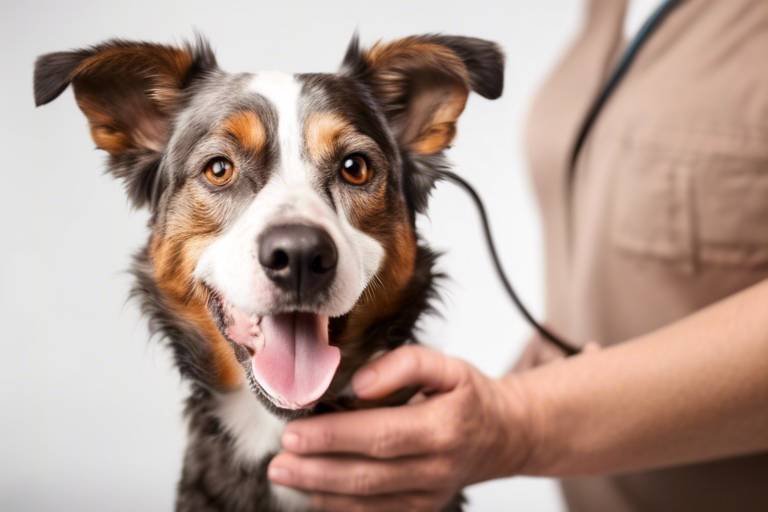Signs of Infection in Pets and When to Seek Help
As loving pet owners, we want nothing more than to see our furry companions happy and healthy. However, just like us, pets can fall ill, and infections are one of the most common health issues they face. Understanding the signs of infection in pets can be a game changer when it comes to their health and well-being. Imagine your pet, once full of energy and joy, suddenly becoming lethargic and withdrawn. It’s heartbreaking, isn’t it? This article explores the common signs of infections in pets, how to identify them, and when it's crucial to seek veterinary assistance for your furry companions.
Recognizing the typical symptoms of infection in pets is essential for their health. Some of the most common signs include:
- Fever: Just like in humans, a fever in pets can indicate an underlying infection. If your pet feels unusually warm to the touch, it’s worth checking their temperature.
- Lethargy: If your pet is less active than usual or seems to be sleeping more, it could be a sign that something isn't right.
- Unusual Behavior: Changes in behavior, such as increased irritability or hiding, can often point to discomfort or pain.
These symptoms can be subtle, so keeping an eye on your pet's day-to-day behavior is crucial. Think of it like being a detective; the more you observe, the better equipped you are to spot something amiss.
Pets can suffer from various infections, including bacterial, viral, and fungal infections. Each type has its own set of symptoms that can help you identify potential problems. For instance, bacterial infections often lead to noticeable signs like pus or swelling, while viral infections might manifest through respiratory issues or gastrointestinal distress. Fungal infections, on the other hand, can cause skin irritations that might be hard to spot without a closer look.
Skin infections are prevalent in pets and can manifest as redness, swelling, or discharge. They can be caused by a variety of factors, including allergies, parasites, or even poor hygiene. If you notice your pet scratching excessively or licking a particular area, it could be a sign of a skin infection. Treatments often involve medicated shampoos, topical ointments, or oral medications, depending on the severity of the infection.
Ear infections are another common issue in pets, particularly in dogs with floppy ears. Signs of ear infections include shaking their head, scratching at their ears, or a foul odor coming from the ear canal. If you suspect an ear infection, it's essential to seek veterinary care promptly, as untreated infections can lead to more severe complications.
Urinary tract infections (UTIs) can affect both dogs and cats. Symptoms to watch for include frequent urination, straining to urinate, or blood in the urine. If you suspect your pet has a UTI, it's crucial to take them to the vet, as these infections can escalate quickly and lead to more severe health issues.
Respiratory infections can lead to serious health complications in pets. Symptoms may include coughing, sneezing, nasal discharge, or difficulty breathing. If your pet exhibits any of these signs, especially if they seem to be in distress, it’s time to seek immediate veterinary attention. Think of it like a fire alarm; don’t ignore the warning signs!
Knowing when to take your pet to the vet is crucial. If your pet shows any combination of the symptoms mentioned above, it's essential to assess the situation carefully. Is your pet eating and drinking normally? Are they engaging in their usual activities? If you notice significant changes, don’t hesitate to consult your veterinarian. They can provide guidance tailored to your pet's specific needs.
Some signs indicate an emergency situation requiring immediate veterinary intervention. Critical symptoms include:
- Severe bleeding
- Inability to stand or walk
- Severe vomiting or diarrhea
- Difficulty breathing
These symptoms should never be ignored and necessitate urgent care. Your pet’s life could depend on it!
Regular veterinary check-ups play an essential role in preventing infections. Routine visits allow your vet to catch potential issues before they escalate. Vaccinations are also a crucial part of keeping your pet healthy and preventing infections. Think of it like a shield; the more layers you have, the better protected you are.
Q: How can I prevent infections in my pet?
A: Regular grooming, maintaining a clean living environment, and ensuring your pet is up-to-date on vaccinations can help prevent infections.
Q: What should I do if I suspect my pet is infected?
A: Monitor their symptoms closely and consult your veterinarian as soon as possible for a proper diagnosis and treatment plan.
Q: Are certain breeds more prone to infections?
A: Yes, some breeds are more susceptible to specific infections due to their anatomy or skin type. Always consult with your vet about your pet's specific risks.

Common Symptoms of Infection
Recognizing the typical symptoms of infection in pets is essential for their health and well-being. Just like humans, our furry friends can exhibit a variety of signs when something is amiss. It’s crucial to be observant and proactive. So, what should you look out for? Here are some common symptoms that may indicate an underlying infection:
Fever is one of the most common signs of infection. If your pet feels unusually warm to the touch, it could be a warning sign. A normal temperature for dogs and cats typically ranges from 100.5°F to 102.5°F. If you suspect a fever, it’s advisable to use a digital thermometer designed for pets to get an accurate reading. A temperature above 103°F is a reason to seek veterinary care.
Another major indicator is lethargy. If your pet seems more tired than usual, is reluctant to play, or is sleeping more than normal, it could be a sign that something is wrong. Think of it like when we feel under the weather; our energy levels drop, and we just want to rest. Similarly, pets may show a lack of interest in their favorite activities, which can be a red flag.
Unusual behavior is another symptom to consider. This can manifest in various ways, such as:
- Excessive scratching or licking
- Changes in appetite (eating less or more)
- Vocalization (whining or growling more than usual)
- Isolation (wanting to be alone)
Additionally, keep an eye out for any physical signs such as redness, swelling, or discharge from any part of the body. These symptoms can often indicate skin infections or other localized issues. For example, if you notice your pet’s skin is inflamed or has a foul smell, it could be a sign of a bacterial infection that needs immediate attention.
Lastly, changes in bathroom habits can also signal an infection. If your pet is urinating more frequently, straining to urinate, or having accidents in the house, it could indicate a urinary tract infection (UTI). Similarly, if your pet has a persistent cough or difficulty breathing, it may suggest a respiratory infection. These symptoms should never be ignored, as they can lead to serious health complications if left untreated.
In summary, being vigilant about your pet's behavior and physical condition can help you catch potential infections early. If you notice any of these symptoms, it’s always best to consult with a veterinarian. Remember, when it comes to our pets, it's better to be safe than sorry!

Types of Infections in Pets
When it comes to our beloved furry companions, understanding the types of infections they can suffer from is crucial for their health and well-being. Just like humans, pets can fall victim to various infections, each with its own set of symptoms and treatments. The most common types include bacterial, viral, and fungal infections. Recognizing the signs associated with these infections can be the difference between a minor issue and a serious health crisis.
Bacterial infections are among the most frequently encountered in pets. They can arise from a variety of sources, including wounds, bites, or even from the environment. Symptoms often include fever, swelling, and discharge from the affected area. For instance, a dog that has been playing rough might develop a bacterial skin infection, leading to redness and irritation. If left untreated, these infections can escalate, causing more severe health issues.
Next up are viral infections, which can be particularly concerning because they often spread quickly and can be more challenging to treat. Common viral infections include canine parvovirus and feline leukemia virus. Symptoms of viral infections may include vomiting, diarrhea, and loss of appetite. It’s essential to be vigilant, as these infections can lead to serious complications if not addressed promptly.
Fungal infections, while less common, are still a significant concern for pet owners. These infections can occur when pets are exposed to fungi in their environment, leading to conditions such as ringworm or aspergillosis. Symptoms often manifest as itchy skin, hair loss, or respiratory issues. Fungal infections can sometimes be mistaken for other skin conditions, which is why it’s crucial to consult with a veterinarian for an accurate diagnosis.
To help you understand these infections better, here's a quick table summarizing the types and their common symptoms:
| Type of Infection | Common Symptoms |
|---|---|
| Bacterial | Fever, swelling, discharge |
| Viral | Vomiting, diarrhea, loss of appetite |
| Fungal | Itchy skin, hair loss, respiratory issues |
In conclusion, being aware of the different types of infections that can affect pets is essential for every pet owner. By recognizing the symptoms early, you can ensure that your furry friend receives the necessary care and treatment to get back to their happy, playful selves. Remember, when in doubt, always consult your veterinarian—they are your best ally in keeping your pet healthy!
Q: How can I prevent infections in my pet?
A: Regular veterinary check-ups, vaccinations, and maintaining good hygiene can help prevent infections.
Q: What should I do if I suspect my pet has an infection?
A: Contact your veterinarian immediately for an evaluation and appropriate treatment.
Q: Are certain breeds more susceptible to infections?
A: Yes, some breeds may be more prone to specific infections, so it's essential to be aware of your pet's breed characteristics.
Skin Infections
Skin infections in pets are more common than you might think, and they can be a source of discomfort for our furry friends. These infections can arise from various causes, including bacteria, fungi, and parasites. It's essential for pet owners to be vigilant and recognize the signs early, as untreated skin infections can lead to more severe health issues. Imagine your pet's skin as a protective barrier; when that barrier is compromised, it opens the door to unwanted invaders that can cause irritation and pain.
One of the most noticeable signs of a skin infection is redness or inflammation in the affected area. You might also see your pet scratching or licking the area excessively, which can exacerbate the problem. In some cases, you might notice a discharge that could be clear, yellow, or even bloody, depending on the severity of the infection. If your pet’s skin is hot to the touch or has an unpleasant odor, these could be additional indicators that something is wrong.
There are several types of skin infections that can affect pets, including:
- Bacterial Infections: Often caused by bacteria like Staphylococcus, these infections can occur when the skin is damaged or irritated.
- Fungal Infections: Ringworm is a well-known fungal infection that can affect both dogs and cats, leading to hair loss and scaling.
- Parasitic Infections: Fleas, mites, and ticks can cause skin infections, leading to itching and inflammation.
So, what should you do if you suspect your pet has a skin infection? First and foremost, it’s crucial to consult your veterinarian. They can perform a thorough examination and may recommend diagnostic tests such as skin scrapings or cultures to identify the underlying cause of the infection. Treatment often involves medications like antibiotics or antifungals, as well as topical treatments to soothe the affected area.
In addition to medical treatment, there are preventive measures you can take to help your pet avoid skin infections. Regular grooming can help keep your pet’s skin healthy and free from irritants. Also, ensure that your pet is on a good parasite prevention program, as these pesky critters can lead to infections if left unchecked.
In summary, being aware of the signs of skin infections and knowing when to seek help can make a significant difference in your pet's health and comfort. Remember, early intervention is always better than waiting for the problem to escalate!
Q: How can I tell if my pet has a skin infection?
A: Look for signs like redness, swelling, excessive scratching, or discharge from the skin. If you notice any of these symptoms, it's best to consult your veterinarian.
Q: Can I treat my pet's skin infection at home?
A: While some minor irritations can be managed at home, it's crucial to consult your veterinarian for proper diagnosis and treatment, especially if the infection seems severe.
Q: What are the common causes of skin infections in pets?
A: Common causes include bacterial infections, fungal infections, allergies, and parasites such as fleas and mites.
Q: How can I prevent skin infections in my pet?
A: Regular grooming, maintaining a healthy diet, and keeping your pet on a good parasite prevention program are key steps in preventing skin infections.
Ear Infections
Ear infections are a common yet often overlooked issue in pets, especially in dogs and cats. These infections can be quite painful and uncomfortable for your furry friends, and they can lead to serious complications if left untreated. So, how can you tell if your pet is suffering from an ear infection? Look for signs such as persistent scratching at the ears, shaking of the head, and unusual odors emanating from the ear canal. It’s as if they’re trying to tell you something is wrong, but they just can’t speak our language!
Ear infections can result from various factors, including allergies, parasites, or even foreign bodies lodged in the ear. Just like us, pets can develop sensitivities that lead to inflammation and infection. For instance, if your pet has a history of allergies, they might be more prone to developing ear infections. In these cases, the ear canal can become inflamed, creating a breeding ground for bacteria and yeast. It’s a bit like a perfect storm brewing in their ears!
When you notice any of the above symptoms, it’s crucial to consult your veterinarian as soon as possible. They will likely conduct a thorough examination, which may include looking inside the ear with an otoscope and possibly taking a sample for testing. This step is essential because the treatment can vary significantly depending on whether the infection is bacterial, fungal, or due to another underlying issue. Think of it as a detective work; the vet needs to get to the root of the problem before prescribing the right treatment.
Once diagnosed, treatment typically involves cleaning the ear and applying appropriate medications. This could include topical ointments, oral medications, or even a combination of both. In some cases, your vet might recommend a special ear cleaner designed to help remove debris and soothe inflammation. Just remember, never attempt to clean your pet's ears without professional guidance, as improper cleaning can worsen the situation.
Prevention is always better than cure! Regular ear cleaning, especially for breeds with floppy ears, can help minimize the risk of infections. Additionally, keeping an eye on your pet's overall health and addressing any allergies or skin conditions promptly can go a long way in preventing ear infections. Just like we take care of our own hygiene, our pets also deserve a little extra attention to keep their ears clean and healthy!
Urinary Tract Infections
Urinary tract infections (UTIs) are a common yet often overlooked issue in our beloved pets, especially in dogs and cats. These infections can lead to discomfort and serious health problems if not addressed promptly. So, how can you tell if your furry friend is suffering from a UTI? One of the first signs to look out for is frequent urination, which might be accompanied by straining or difficulty in urinating. You may notice your pet making frequent trips to the litter box or outside, but producing little to no urine. This can be quite distressing for both the pet and the owner, as it often indicates that something is amiss.
Another significant symptom to watch for is blood in the urine, which can be alarming. If you spot this, it’s crucial to act quickly. Additionally, pets with UTIs may exhibit signs of discomfort, such as whining or crying while urinating. Lethargy and a decrease in appetite are also common indicators that your pet is not feeling well. If your dog or cat is exhibiting these symptoms, it’s essential to consult your veterinarian as soon as possible.
UTIs can be caused by a variety of factors, including bacteria entering the urinary tract, underlying health conditions, or even anatomical abnormalities. In female dogs, the risk is higher due to their shorter urethra, which allows bacteria easier access to the bladder. It's important to note that while UTIs are more common in females, male pets can also be affected. If left untreated, a UTI can lead to more severe complications, such as kidney infections or bladder stones, which can be life-threatening.
To diagnose a UTI, your veterinarian will likely perform a urinalysis to check for the presence of bacteria, blood, or crystals in the urine. They may also recommend imaging tests to rule out any structural issues. Treatment usually involves antibiotics to eliminate the infection, and your vet may suggest dietary changes or increased water intake to help flush out the urinary system. In some cases, additional medications may be prescribed to alleviate discomfort.
As a pet owner, it’s vital to be proactive in preventing UTIs. Regular vet check-ups, maintaining proper hygiene, and ensuring your pet stays hydrated can significantly reduce the likelihood of infections. Remember, early detection and treatment are key to keeping your furry friend healthy and happy!
- What are the common signs of a UTI in pets? Look for frequent urination, straining to urinate, blood in the urine, and signs of discomfort.
- Can UTIs be prevented? Yes, regular vet check-ups, maintaining hygiene, and ensuring adequate hydration can help prevent UTIs.
- How are UTIs diagnosed? A urinalysis is typically performed to check for bacteria, blood, or crystals in the urine.
- What is the treatment for a UTI? Treatment usually involves antibiotics, and your vet may recommend dietary changes and increased water intake.
Respiratory Infections
Respiratory infections in pets can be as concerning as they are common. Just like humans, our furry friends can catch colds or develop more serious respiratory conditions that can leave them coughing, sneezing, and feeling miserable. It's essential to understand the signs of respiratory infections so you can act quickly and ensure your pet receives the care they need. If you’ve ever seen your dog or cat struggling to breathe or making unusual sounds, you know how alarming it can be. These infections can range from mild to severe, and recognizing the symptoms early can make a world of difference.
One of the primary signs of a respiratory infection is a persistent cough. You might notice your pet coughing more than usual, and it may sound dry or wet, depending on the type of infection. Along with coughing, other common symptoms include:
- Labored breathing: If your pet seems to be struggling to catch their breath, it’s time to seek help.
- Excessive sneezing: Frequent sneezing can indicate an upper respiratory infection.
- Nasal discharge: A runny nose can be a telltale sign of an infection, whether it’s clear, yellow, or green.
- Lethargy: If your pet is less active than usual, it could be a sign that they’re not feeling well.
- Loss of appetite: When pets are sick, they often lose interest in food, which is a significant red flag.
Respiratory infections can be caused by various factors, including viruses, bacteria, and even environmental allergens. For instance, kennel cough is a highly contagious respiratory infection caused by a combination of bacteria and viruses, and it often spreads in places where dogs congregate, like boarding facilities or dog parks. On the other hand, feline upper respiratory infections are common in cats and can be triggered by viruses like feline herpesvirus or calicivirus.
It’s important to note that some respiratory infections can lead to serious complications, such as pneumonia, especially in young, elderly, or immunocompromised pets. Therefore, if you notice any combination of the symptoms mentioned above, it’s crucial to consult your veterinarian as soon as possible. They may recommend diagnostic tests, such as X-rays or blood tests, to determine the exact cause of the infection and the best course of treatment.
In many cases, treatment may involve medications, such as antibiotics for bacterial infections or antiviral medications for viral infections. Additionally, supportive care, including hydration and rest, is vital for your pet’s recovery. Just like humans need time to recover from a cold, your pets will benefit from a cozy spot to rest and plenty of love and attention from you.
In conclusion, being aware of the signs of respiratory infections in your pets can help you act quickly and ensure they receive the necessary care. Always keep an eye on their behavior and health, and don’t hesitate to reach out to your veterinarian if you have any concerns. Your furry companions rely on you to be their voice when they can’t express their discomfort!
Q: What are the most common signs of a respiratory infection in pets?
A: Common signs include coughing, sneezing, nasal discharge, labored breathing, lethargy, and loss of appetite.
Q: How can I prevent respiratory infections in my pet?
A: Regular veterinary check-ups, vaccinations, and minimizing exposure to sick animals can help prevent respiratory infections.
Q: When should I take my pet to the vet for a respiratory issue?
A: If your pet shows any signs of respiratory distress, such as difficulty breathing or persistent coughing, seek veterinary care immediately.
Q: Can respiratory infections be contagious?
A: Yes, some respiratory infections, like kennel cough in dogs, are highly contagious and can spread easily among animals.

When to Seek Veterinary Help
As a pet owner, it can sometimes feel like you're walking a tightrope, trying to balance your love for your furry friend with the need to ensure their health and well-being. Knowing when to seek veterinary help is crucial in this balancing act. Ignoring the signs of potential health issues can lead to more serious problems down the line, so it's essential to be vigilant. If you notice any of the following symptoms, it’s time to take action and consult your veterinarian:
- Persistent Vomiting or Diarrhea: If your pet has been vomiting or experiencing diarrhea for more than 24 hours, it could indicate a serious underlying issue, such as an infection or toxicity.
- Difficulty Breathing: Struggling to breathe is a serious symptom that requires immediate attention. If your pet is wheezing, coughing excessively, or showing signs of distress, don’t wait.
- Severe Lethargy: While pets enjoy their naps, sudden and extreme lethargy can signal a health crisis. If your pet is unresponsive or unable to engage in their usual activities, it’s time to visit the vet.
- Changes in Appetite: A sudden increase or decrease in appetite can be a red flag. If your pet refuses to eat for more than a day or is excessively hungry, this could indicate health problems.
- Unexplained Weight Loss: If your pet is losing weight without any changes in diet or exercise, it’s crucial to investigate the cause.
These signs are just the tip of the iceberg. It’s important to listen to your instincts as a pet owner. If something feels off, don’t hesitate to reach out to your veterinarian. Remember, your vet is your partner in ensuring your pet’s health.
In addition to recognizing symptoms, understanding the urgency of your pet's condition is vital. For example, if your pet has been bitten by another animal or has sustained a serious injury, immediate veterinary care is non-negotiable. In these cases, the faster you act, the better the outcome for your beloved companion.
Another aspect to consider is the age and breed of your pet. Older pets or those with pre-existing conditions may require more immediate attention than younger, healthier animals. It's like having a classic car; it might need a little more care and attention than a newer model. Always keep in mind that some breeds are more prone to specific health issues, so being aware of your pet's unique needs can help you act quickly when necessary.
Regular check-ups with your veterinarian can also play a significant role in preventing serious health issues. During these visits, your vet can identify potential problems before they escalate, keeping your furry friend happy and healthy. Think of it as a tune-up for your pet; it’s much easier to maintain good health than to deal with a breakdown later!
Some symptoms should never be ignored and require immediate veterinary intervention. These include:
- Severe bleeding
- Inability to stand or walk
- Severe pain or distress
- Exposure to toxins or poisons
- Seizures
If you observe any of these critical signs, don’t wait for symptoms to worsen. Act quickly and get your pet the help they need. Remember, being proactive can save lives.
Lastly, regular veterinary check-ups play an essential role in maintaining your pet's health and preventing infections. Just like you wouldn’t skip your annual physical, your pet deserves the same level of care. Routine visits can help catch issues before they become serious, and vaccinations are crucial in preventing diseases. Think of your veterinarian as your pet's personal health coach, guiding you on the best practices for a long and healthy life together.
Q: How often should I take my pet to the vet?
A: Generally, adult pets should have a check-up at least once a year, while puppies and kittens may require more frequent visits. Always consult your veterinarian for a schedule tailored to your pet's specific needs.
Q: What should I do if my pet has a minor injury?
A: For minor injuries, you can clean the area with mild soap and water, but if there’s any swelling, bleeding, or signs of infection, it’s best to consult your vet.
Q: Are there any home remedies for pet infections?
A: While some home remedies can help with minor issues, it’s always best to consult your veterinarian before trying anything. They can provide the safest and most effective treatment options.
Emergency Situations
When it comes to our beloved pets, there are moments that demand immediate attention. Recognizing can be the difference between life and death. So, how do you know when to rush your furry friend to the vet? It’s all about being aware of the signs. For instance, if your pet is experiencing severe difficulty breathing, this is a serious red flag. Imagine trying to catch your breath after running a marathon – that’s how your pet feels, and they need help fast!
Other critical symptoms to watch for include:
- Uncontrolled bleeding: If you notice your pet bleeding profusely, whether from a wound or internally, it’s time to act.
- Severe vomiting or diarrhea: If your pet is vomiting multiple times or has persistent diarrhea, especially if it’s accompanied by blood, don’t wait!
- Seizures: Witnessing your pet seize can be terrifying. If it happens, you should seek veterinary care immediately.
- Signs of pain: If your pet is whimpering, whining, or showing unusual aggression, they might be in pain.
- Ingestion of toxic substances: If you suspect your pet has eaten something harmful, such as chocolate or certain plants, get them to a vet right away.
Each of these symptoms can indicate a serious health issue that requires prompt veterinary intervention. It’s always better to err on the side of caution. If you're unsure, call your vet and describe the symptoms. They can guide you on whether it’s an emergency or if you can wait for a regular appointment.
Additionally, keep a list of emergency contacts handy, including your regular vet, an emergency animal clinic, and even a poison control hotline. Just like having a fire extinguisher in your home for emergencies, being prepared can save precious time when every second counts.
In conclusion, being a vigilant pet owner means understanding the signs of distress and knowing when to act. Your pet relies on you to recognize when something is off, so trust your instincts. If something doesn’t feel right, it’s always best to seek help!
Q: What should I do if my pet has a seizure?
A: Stay calm and ensure your pet is in a safe area. Do not put anything in their mouth. Time the seizure and contact your veterinarian immediately afterward.
Q: How can I tell if my pet is in pain?
A: Signs of pain can include whining, panting, limping, or changes in behavior or appetite. If you suspect your pet is in pain, consult your vet.
Q: What are some common household items that are toxic to pets?
A: Common toxic items include chocolate, grapes, onions, certain plants (like lilies), and cleaning supplies. Always keep these out of reach!
Q: How often should my pet have check-ups?
A: Generally, pets should have a check-up at least once a year. However, older pets or those with health issues may require more frequent visits.
Regular Check-ups
When it comes to keeping our furry friends healthy, at the veterinarian are absolutely crucial. Just like how we schedule annual physicals for ourselves, our pets also need routine examinations to catch any potential health issues before they become serious. These visits are not just about vaccinations; they are an opportunity for your vet to assess your pet's overall well-being, monitor their weight, and check for any early signs of infection or disease.
During a typical check-up, your veterinarian will perform a thorough examination that includes checking your pet's heart rate, breathing, and temperature. They will also examine your pet's eyes, ears, and teeth, ensuring that everything is in tip-top shape. It's like a mini health report card for your pet! If any abnormalities are detected, your vet can recommend further tests or treatments, which can be a game-changer in preventing more serious health issues down the line.
Additionally, these visits allow you to discuss any concerns you might have with your vet, whether it's about your pet's behavior, diet, or any unusual symptoms you've noticed. It's important to remember that pets can’t speak up when something is wrong, so being proactive in these conversations can lead to better outcomes. Preventative care is always better than reactive care, and regular check-ups can save you and your pet from a lot of unnecessary stress and expense.
Moreover, vaccinations are a critical part of these check-ups. They protect your pet from various diseases that could be life-threatening. The CDC recommends that pets receive vaccinations based on their age, health status, and lifestyle. For example, if your dog frequently interacts with other dogs at parks or daycare, they may need specific vaccines to protect them against kennel cough or canine influenza.
To help you understand the importance of these check-ups, here’s a quick overview of what they typically include:
| Check-Up Component | Description |
|---|---|
| Physical Examination | A thorough assessment of your pet's health, including checking ears, eyes, teeth, and skin. |
| Weight Monitoring | Tracking weight to prevent obesity or malnutrition, which can lead to other health issues. |
| Vaccinations | Administering necessary vaccines to protect against various diseases. |
| Preventative Treatments | Recommendations for flea, tick, and heartworm prevention based on your pet's lifestyle. |
In summary, regular check-ups are an investment in your pet's health that can lead to a longer, happier life. Think of it as a way to catch problems early, much like how a stitch in time saves nine. By prioritizing these visits, you’re not just being a responsible pet owner; you’re being an advocate for your pet's health and well-being. So, mark your calendars and make those appointments because your furry friend deserves the best!
- How often should I take my pet for a check-up? Generally, it’s recommended to take your pet for a check-up at least once a year. However, older pets or those with pre-existing conditions may require more frequent visits.
- What should I expect during a check-up? Expect a thorough examination, discussion of your pet's health history, and recommendations for vaccinations and preventative care.
- Are check-ups expensive? The cost can vary depending on your location and the services provided, but investing in regular check-ups can save you money in the long run by preventing serious health issues.
Frequently Asked Questions
- What are the common signs of infection in pets?
Common signs of infection in pets include fever, lethargy, loss of appetite, unusual behavior, and physical symptoms like swelling or discharge. If you notice any of these signs, it’s important to monitor your pet closely.
- How can I tell if my pet has a skin infection?
Skin infections often present as redness, swelling, or discharge from the affected area. You may also notice your pet scratching or licking excessively. If you see these signs, it’s best to consult your veterinarian for an accurate diagnosis and treatment plan.
- What causes ear infections in pets?
Ear infections in pets can be caused by a variety of factors, including allergies, moisture, and foreign objects. Symptoms to watch for include scratching at the ears, shaking the head, and a foul odor from the ear. If you suspect an ear infection, seek veterinary care promptly.
- Are urinary tract infections common in pets?
Yes, urinary tract infections (UTIs) are relatively common in both dogs and cats. Symptoms may include frequent urination, straining to urinate, or blood in the urine. If you notice any of these signs, it’s crucial to get your pet to the vet for evaluation and treatment.
- When should I seek emergency veterinary help for my pet?
You should seek emergency veterinary help if your pet exhibits severe symptoms such as difficulty breathing, persistent vomiting, seizures, or signs of severe pain. These symptoms can indicate a serious health issue that requires immediate attention.
- How often should I take my pet for a check-up?
It's recommended to take your pet for a veterinary check-up at least once a year. Regular visits help in early detection of potential health issues and ensure that your pet is up-to-date on vaccinations and preventative care.



















